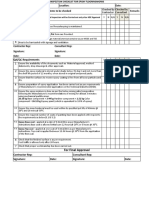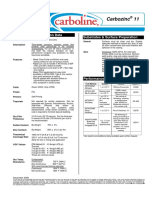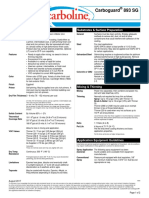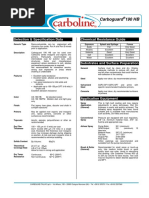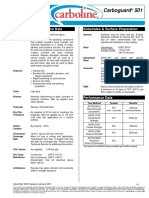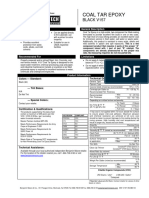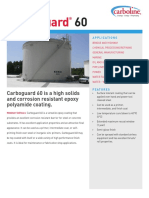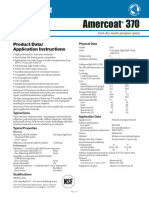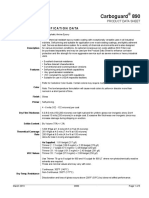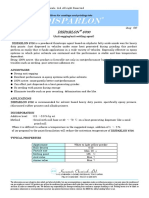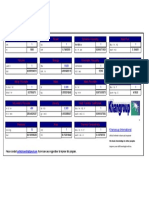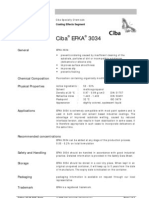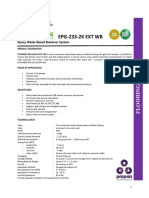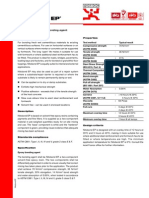Carboguard Low Haps Epoxy: Selection & Specification Data Substrates & Surface Preparation
Carboguard Low Haps Epoxy: Selection & Specification Data Substrates & Surface Preparation
Uploaded by
Imran AhmadCopyright:
Available Formats
Carboguard Low Haps Epoxy: Selection & Specification Data Substrates & Surface Preparation
Carboguard Low Haps Epoxy: Selection & Specification Data Substrates & Surface Preparation
Uploaded by
Imran AhmadOriginal Title
Copyright
Available Formats
Share this document
Did you find this document useful?
Is this content inappropriate?
Copyright:
Available Formats
Carboguard Low Haps Epoxy: Selection & Specification Data Substrates & Surface Preparation
Carboguard Low Haps Epoxy: Selection & Specification Data Substrates & Surface Preparation
Uploaded by
Imran AhmadCopyright:
Available Formats
Carboguard® Low HAPs Epoxy
Selection & Specification Data Substrates & Surface Preparation
Generic Type Epoxy Polyamide General Surfaces must be clean and dry. Employ
adequate methods to remove dirt, dust, oil and
Description Carboguard Low HAPs Epoxy is a versatile all other contaminants that could interfere with
corrosion resistant coating. Used either as a adhesion of the coating.
primer, intermediate coat, or self-priming finish
over steel and inorganic zinc primers. May be Steel For most applications:
topcoated with itself, or a broad variety of high SSPC-SP6 to obtain a blast profile of 1.0-2.0
performance finish coats. Has surface tolerant mils (25-50 microns). May also be applied over
properties. SSPC-SP 3 for certain applications.
Features Ready to apply after mixing; no sweat-in time
Concrete Concrete must be cured 28 days at 75°F (24°C)
or thinning required
Economical fit for use epoxy and 50% relative humidity or equivalent. Prepare
surfaces in accordance with ASTM D4258
Available in a variety of rapid tint colors
Surface Cleaning of Concrete and ASTM D4259
Attractive low sheen for tank exteriors
Used as a primer, intermediate or finish coat Abrading Concrete. Voids in concrete may
require surfacing.
Can be applied over power tool cleaned
surfaces
Rapid recoat primer. Topcoat in 30 minutes
@75°F (24°C) substrate temperature
• Less than 1.8 lbs/solid gal of HAPs
Color (0700) gray or (0400) salmon
Performance Data
Finish Low sheen Low HAPs Epoxy
Test Method System Results Report #
Primers Self-priming. May be applied over organic and Blasted Steel
inorganic zinc rich primers. A mist coat may be ASTM D4541 1600 psi
2 ct. Low 09453
required to minimize bubbling over zinc rich Adhesion (Pneumatic)
HAPs Epoxy
primers.
90° bend produced
Blasted Steel
Topcoats Acrylics, Alkyds, Epoxies, Polyurethanes ASTM D522 no cracking, ¾”
1 ct. Low 09453
Flexibility Cylindrical Mandrel
Dry Film 3.0-5.0 mils (75-125 microns) per coat as a HAPs Epoxy
Bend
Thickness primer or an intermediate. Two coats at 3-5 mils Test reports and additional data available upon written request.
(75-125 microns) per coat may be used direct-to-
metal.
4.0-6.0 mils (100-150 microns) per coat as a
finish coat over a primer. Do not exceed 10 mils
(250 microns) in a single coat. Excessive film
thickness over inorganic zincs may increase
damage during shipping or erection.
Solids Content By Volume: 62% ± 2%
2 2
Theoretical 962 mil ft (24.0 m /l at 25 microns)
2 2
Coverage Rate 320 ft at 3 mils (8.0 m /l at 75 microns)
Allow for loss in mixing and application.
VOC Values As supplied: 2.80 lbs./gal (336 g/l)
Thinned:
15 oz/gal w/ #72: 3.3 lbs./gal (395 g/l)
These are nominal values and may vary slightly
with color.
Dry Temp. Continuous: 200°F (93°C)
Resistance Non-Continuous: 250°F (121°C)
Discoloration and loss of gloss is observed
above 200°F (93°).
Limitations Epoxies lose gloss, discolor and eventually chalk
in sunlight exposure.
Not recommended for immersion service.
January 2007 replaces September 2006 N 8925
To the best of our knowledge the technical data contained herein is true and accurate on the date of publication and is subject to change without prior notice. User must contact Carboline Company to
verify correctness before specifying or ordering. No guarantee of accuracy is given or implied. We guarantee our products to conform to Carboline quality control. We assume no responsibility for
coverage, performance or injuries resulting from use. Liability, if any, is limited to replacement of products. NO OTHER WARRANTY OR GUARANTEE OF ANY KIND IS MADE BY CARBOLINE,
EXPRESS OR IMPLIED, STATUTORY, BY OPERATION OF LAW, OR OTHERWISE, INCLUDING MERCHANTABILITY AND FITNESS FOR A PARTICULAR PURPOSE. Carboline® and Carboguard®
are registered trademarks of Carboline Company.
Carboguard® Low HAPs Epoxy Carboline 8000 Series has been specifically designed for OEM applications.
For specific product requirements or process painting recommendations contact Carboline OEM Engineered Finishes Division.
Application Equipment Application Conditions
Listed below are general equipment guidelines for the application of this product.
Job site conditions may require modifications to these guidelines to achieve the Condition Material Surface Ambient Humidity
desired results.
General Guidelines: 60°-85°F 60°-85°F 60°-90°F
Normal 0-80%
(16°-29°C) (16°-29°C) (16°-32°C)
Spray Application The following spray equipment has been found suitable
(General) and is available from manufacturers such as Binks,
50°F 50°F 50°F
Minimum 0%
DeVilbiss and Graco. (10°C) (10°C) (10°C)
90°F 125°F 110°F
Conventional Pressure pot equipped with dual regulators, 3/8” I.D. Maximum 80%
Spray minimum material hose, .070” I.D. fluid tip and
(32°C) (52°C) (43°C)
appropriate air cap. This product simply requires the substrate temperature to be above the
dew point. Condensation due to substrate temperatures below the dew
Airless Spray Pump Ratio: 30:1 (min.) point can cause flash rusting on prepared steel and interfere with
GPM Output: 2.5 (min.)
proper adhesion to the substrate. Special application techniques may
Material Hose: 3/8” I.D. (min.)
Tip Size: .017”-.021” be required above or below normal application conditions.
Output PSI: 2100-2300
Filter Size: 60 mesh
Teflon packings are recommended and available from
Curing Schedule
the pump manufacturer.
Surface Temp.
Brush & Roller Multiple coats may be required to obtain desired & 50% Relative Dry to Recoat Dry to Maximum
(General) appearance, recommended dry film thickness and Humidity Or Topcoat Handle Recoat Time
adequate hiding. Avoid excessive re-brushing or re-
rolling. For best results, tie-in within 10 minutes at 75°F 50°F (10°C) 2 Hours 24 hours 1 Year
(24°C).
60°F (16°C) 1 Hour 10 hours 1 Year
Brush Use a medium bristle brush. 75°F (24°C) 30 Minutes 7 hours 1 Year
Roller Use a short-nap synthetic roller cover with phenolic 90°F (32°C) 15 Minutes 4 hours 1 Year
core. These times are based on a 4.0-6.0 mil (100-150 micron) dry film
thickness for non-immersion. Higher film thickness, insufficient
Mixing & Thinning ventilation or cooler temperatures will require longer cure times and
could result in solvent entrapment and premature failure. Excessive
Mixing Power mix separately, then combine and power mix. humidity or condensation on the surface during curing can interfere
DO NOT MIX PARTIAL KITS. with the cure, can cause discoloration and may result in a surface
haze. Any haze or blush must be removed by water washing before
Ratio 1:1 Ratio (A to B) recoating. If the maximum recoat times have been exceeded, the
Thinning Normally not required but may thin as follows: surface must be abraded by sweep blasting or sanding prior to the
Up to 15 oz/gal (12%) w/ #72. application of additional coats. For force curing, contact Carboline
Use of thinners other than those supplied or Technical Service for specific requirements.
recommended by Carboline may adversely affect
product performance and void product warranty,
whether expressed or implied. Packaging, Handling & Storage
Pot Life 4 Hours at 75°F (24°C) Shipping Weight 2 Gallon Kit 10 Gallon Kit
Pot life ends when coating loses body and begins to (Approximate) 26 lbs. (12 kg) 127 lbs. (58 kg)
sag. Pot life times will be less at higher temperatures.
Flash Point (Setaflash) Part A: 82°F
Cleanup & Safety Part B: 74°F
Cleanup Use #72 Thinner or Acetone. In case of spillage,
Storage (General) Store Indoors.
absorb and dispose of in accordance with local
applicable regulations.
Storage Temperature 40° - 110°F (4°- 43°C)
Safety Read and follow all caution statements on this product & Humidity 0-100% Relative Humidity
data sheet and on the MSDS for this product. Employ
normal workmanlike safety precautions. Hypersensitive Shelf Life Part A & B: Min. 36 months at 75°F
persons should wear protective clothing, gloves and use
protective cream on face, hands and all exposed areas. (24°C)
Ventilation When used in enclosed areas, thorough air circulation *Shelf Life: (actual stated shelf life) when kept at
must be used during and after application until the recommended storage conditions and in original
coating is cured. The ventilation system should be unopened containers.
capable of preventing the solvent vapor concentration
from reaching the lower explosion limit for the solvents
used. User should test and monitor exposure levels to
insure all personnel are below guidelines. If not sure or
if not able to monitor levels, use MSHA/NIOSH
approved respirator.
Caution This product contains flammable solvents. Keep away
from sparks and open flames. All electrical equipment
and installations should be made and grounded in
accordance with the National Electric Code. In areas
where explosion hazards exist, workmen should be
required to use non-ferrous tools and wear conductive
and non-sparking shoes.
January 2007 replaces September 2006 N
To the best of our knowledge the technical data contained herein is true and accurate on the date of publication and is subject to change without prior notice. User must contact Carboline Company to
verify correctness before specifying or ordering. No guarantee of accuracy is given or implied. We guarantee our products to conform to Carboline quality control. We assume no responsibility for
coverage, performance or injuries resulting from use. Liability, if any, is limited to replacement of products. NO OTHER WARRANTY OR GUARANTEE OF ANY KIND IS MADE BY CARBOLINE,
EXPRESS OR IMPLIED, STATUTORY, BY OPERATION OF LAW, OR OTHERWISE, INCLUDING MERCHANTABILITY AND FITNESS FOR A PARTICULAR PURPOSE. Carboline® and Carboguard®
are registered trademarks of Carboline Company.
You might also like
- Checklist For Epoxy CoatingDocument1 pageChecklist For Epoxy CoatingMani Appa64% (11)
- Carbozinc 11Document2 pagesCarbozinc 11Victor A. Claure Manzoni100% (1)
- Plate Heat Exchanger ALFA LAVAL M3 M20Document63 pagesPlate Heat Exchanger ALFA LAVAL M3 M20Arjav Desai100% (4)
- KCC FLOOR COATING (Catalogue) PDFDocument16 pagesKCC FLOOR COATING (Catalogue) PDFchriscivil12No ratings yet
- Hand Book of Adhesives With Their Formulates PDFDocument11 pagesHand Book of Adhesives With Their Formulates PDFRavi Prakash0% (2)
- Carboguard 60: Selection & Specification Data Substrates & Surface PreparationDocument2 pagesCarboguard 60: Selection & Specification Data Substrates & Surface PreparationImran AhmadNo ratings yet
- Carbomastic 801 PDFDocument2 pagesCarbomastic 801 PDFkayNo ratings yet
- Carboguard 890 EF PDS 9-06Document2 pagesCarboguard 890 EF PDS 9-06Ckaal74No ratings yet
- Carboguard 893 SG PDSDocument2 pagesCarboguard 893 SG PDSAhmed ElbahrawyNo ratings yet
- Carbomastic15BNX EngDocument2 pagesCarbomastic15BNX Engfazeel mohammedNo ratings yet
- Carboguard 954 HB PDS 7-10Document2 pagesCarboguard 954 HB PDS 7-10raja020No ratings yet
- Carbozinc 11 GP Eng Rev201703 20170330Document2 pagesCarbozinc 11 GP Eng Rev201703 20170330tiennv.blcmNo ratings yet
- Carboguard 893 SG PDFDocument2 pagesCarboguard 893 SG PDFQA QCNo ratings yet
- Carboline Carboguard 890 PDSDocument2 pagesCarboline Carboguard 890 PDSSamNo ratings yet
- F13 - Carboguard 893-Zn PDS 10-09Document2 pagesF13 - Carboguard 893-Zn PDS 10-09naveenbaskaran1989No ratings yet
- Bitumastic 300 MDocument2 pagesBitumastic 300 MANIBALLOPEZVEGA100% (1)
- Carboguard 890 PDSDocument2 pagesCarboguard 890 PDSKhemaraj PathNo ratings yet
- Carbozinc Data SheetDocument2 pagesCarbozinc Data SheetIra Purnama SariNo ratings yet
- Carboguard 890 GF PDSDocument2 pagesCarboguard 890 GF PDStiennv.blcmNo ratings yet
- Carbozinc 859Document2 pagesCarbozinc 859Khemaraj PathNo ratings yet
- Carbothane 134 HG Polyurethane Coating MSDSDocument13 pagesCarbothane 134 HG Polyurethane Coating MSDSjgzlzNo ratings yet
- Carbomastic 18 NTDocument2 pagesCarbomastic 18 NTtiennv.blcmNo ratings yet
- Carbothane 134 HG PDSDocument2 pagesCarbothane 134 HG PDSKhemaraj Path100% (1)
- Product Data: Carboguard 190 HDocument2 pagesProduct Data: Carboguard 190 HClarkFedele27100% (1)
- Sherwin Williams Paint - Bond Plex MSDSDocument4 pagesSherwin Williams Paint - Bond Plex MSDSOitreismas OitreismasNo ratings yet
- Carbozinc 11 HS PDSDocument2 pagesCarbozinc 11 HS PDSvietrossNo ratings yet
- Selection & Specification Data Substrates & Surface PreparationDocument2 pagesSelection & Specification Data Substrates & Surface PreparationJuanNo ratings yet
- Arexol Lac Tds - en 2023Document2 pagesArexol Lac Tds - en 2023Vlad RosuNo ratings yet
- Carbothane 134 HG PDSDocument2 pagesCarbothane 134 HG PDSfazeel mohammedNo ratings yet
- Carbozinc 11 VOC PDFDocument2 pagesCarbozinc 11 VOC PDFsrikarmallampatiNo ratings yet
- Carboguard 501 PDS 12-03 PDFDocument2 pagesCarboguard 501 PDS 12-03 PDFImran AhmadNo ratings yet
- Corotech v157 - Tds en OkfDocument3 pagesCorotech v157 - Tds en OkfNasreldin SamyNo ratings yet
- Carboguard 703Document2 pagesCarboguard 703Achraf BoudayaNo ratings yet
- Carbozinc 11Document4 pagesCarbozinc 11DuongthithuydungNo ratings yet
- Carbomastic 15: Selection & Specification Data Substrates & Surface PreparationDocument2 pagesCarbomastic 15: Selection & Specification Data Substrates & Surface PreparationMarcos MacaiaNo ratings yet
- CarbolineDocument18 pagesCarbolineimaduddinshaNo ratings yet
- Abecote 400 HBDocument3 pagesAbecote 400 HBengramir07No ratings yet
- Carboguard: Carboguard 60 Is A High Solids and Corrosion Resistant Epoxy Polyamide CoatingDocument2 pagesCarboguard: Carboguard 60 Is A High Solids and Corrosion Resistant Epoxy Polyamide CoatingMuhammad Prima JayaNo ratings yet
- Transocean - C5-M Typical Coating SystemDocument2 pagesTransocean - C5-M Typical Coating SystemMuhammad Nu'manNo ratings yet
- Carboguard 690: Selection & Specification Data Selection & Specification DataDocument2 pagesCarboguard 690: Selection & Specification Data Selection & Specification DataImran AhmadNo ratings yet
- Carbomastic 18NT PDSDocument2 pagesCarbomastic 18NT PDStiennv.blcmNo ratings yet
- PDS - Carboguard 890 (7) (May 2019 Replaces November 2015)Document4 pagesPDS - Carboguard 890 (7) (May 2019 Replaces November 2015)nafis2u2k3No ratings yet
- Durebild STE: Surface Tolerant High Build High Solids Epoxy CoatingDocument3 pagesDurebild STE: Surface Tolerant High Build High Solids Epoxy CoatinglivefreakNo ratings yet
- Resutile Topcoat SD System Guide SWDocument4 pagesResutile Topcoat SD System Guide SWServandoNo ratings yet
- PPG Amercoat 370 Data SheetDocument3 pagesPPG Amercoat 370 Data SheetAchraf Boudaya0% (1)
- Carboguard 193: Selection & Specification DataDocument4 pagesCarboguard 193: Selection & Specification DataGraciele SantosNo ratings yet
- Carbothane 834 PDSDocument2 pagesCarbothane 834 PDSMuhammad RizwanNo ratings yet
- Carboguard 890 PDSDocument5 pagesCarboguard 890 PDSAchraf BoudayaNo ratings yet
- Carbothane 134: Selection & Specification Data Substrates & Surface PreparationDocument2 pagesCarbothane 134: Selection & Specification Data Substrates & Surface PreparationMarcos MacaiaNo ratings yet
- Sanitile 120 PDSDocument4 pagesSanitile 120 PDSDuongthithuydungNo ratings yet
- Interprime_741-Internal primerDocument4 pagesInterprime_741-Internal primerSantosh SrivastavaNo ratings yet
- Sealbond EFC100 EPOXY FLOORING SELF-LEVELINGDocument3 pagesSealbond EFC100 EPOXY FLOORING SELF-LEVELINGJhoreen FabitoNo ratings yet
- Amerlock 400: Product Data/ Application InstructionsDocument4 pagesAmerlock 400: Product Data/ Application InstructionsPedro Nelvedir Barrera CelyNo ratings yet
- Carbozinc 11: Selection & Specification Data Substrates & Surface PreparationDocument2 pagesCarbozinc 11: Selection & Specification Data Substrates & Surface PreparationClarkFedele27No ratings yet
- Sealbond EPC-100 - TDS & MSDSDocument7 pagesSealbond EPC-100 - TDS & MSDSmaridelljabonilloNo ratings yet
- Carbothane 133 HB PDSDocument3 pagesCarbothane 133 HB PDStiennv.blcmNo ratings yet
- Carboguard 1209: Selection & Specification DataDocument4 pagesCarboguard 1209: Selection & Specification DataQuy Dom100% (2)
- C PLATE TdsDocument1 pageC PLATE TdsEdwin TacoNo ratings yet
- Durebild HSE: High Build Two Pack Epoxy CoatingDocument3 pagesDurebild HSE: High Build Two Pack Epoxy CoatinglivefreakNo ratings yet
- Bitumastic 300S_Eng (rev.2015)Document2 pagesBitumastic 300S_Eng (rev.2015)Norman Mokoginta,ST,MBANo ratings yet
- Carboguard 636 XT PDSDocument4 pagesCarboguard 636 XT PDSCarlos Rojas HandalNo ratings yet
- Flowchem EPN - ENGDocument2 pagesFlowchem EPN - ENGbassem kooliNo ratings yet
- Carbothane 133 HB PDS PDFDocument5 pagesCarbothane 133 HB PDS PDFskNo ratings yet
- EC Tech Report Marine CoatingsFrom EverandEC Tech Report Marine CoatingsVincentz Network GmbH & Co. KGNo ratings yet
- Desmodur HL BA - en - 00130850 12978366 13422252Document3 pagesDesmodur HL BA - en - 00130850 12978366 13422252Imran AhmadNo ratings yet
- TMP - Hesse - PUR - Überzugslack - DU - 51xGlanzgrad-1-Technische Information-1690371992680Document3 pagesTMP - Hesse - PUR - Überzugslack - DU - 51xGlanzgrad-1-Technische Information-1690371992680Imran AhmadNo ratings yet
- BONDERITE M AD 4977 en - USDocument2 pagesBONDERITE M AD 4977 en - USImran AhmadNo ratings yet
- Rodos en 70Document88 pagesRodos en 70Imran AhmadNo ratings yet
- Carboguard 690: Selection & Specification Data Selection & Specification DataDocument2 pagesCarboguard 690: Selection & Specification Data Selection & Specification DataImran AhmadNo ratings yet
- Cereclor 48: Typical PropertiesDocument1 pageCereclor 48: Typical PropertiesImran AhmadNo ratings yet
- Prepalene X en - USDocument2 pagesPrepalene X en - USImran AhmadNo ratings yet
- Carboguard 501 PDS 12-03 PDFDocument2 pagesCarboguard 501 PDS 12-03 PDFImran AhmadNo ratings yet
- BeckamineDocument4 pagesBeckamineImran AhmadNo ratings yet
- ETERAC 7401 TDS (Leveling Additive)Document1 pageETERAC 7401 TDS (Leveling Additive)Imran AhmadNo ratings yet
- ETERKYD 50713-S-60 TDS (Non Stick Coating) PDFDocument2 pagesETERKYD 50713-S-60 TDS (Non Stick Coating) PDFImran Ahmad0% (1)
- VISCOMETER Low Cost Digital Model DV-EDocument1 pageVISCOMETER Low Cost Digital Model DV-EImran AhmadNo ratings yet
- Eternal Resin 1 PDFDocument15 pagesEternal Resin 1 PDFImran AhmadNo ratings yet
- Eternal 3 PDFDocument8 pagesEternal 3 PDFImran AhmadNo ratings yet
- Silbond 40 PDLDocument1 pageSilbond 40 PDLImran AhmadNo ratings yet
- Eternal 3 PDFDocument8 pagesEternal 3 PDFImran AhmadNo ratings yet
- Ox 70Document1 pageOx 70Imran AhmadNo ratings yet
- Eterac 7226-1-B-60Document2 pagesEterac 7226-1-B-60Imran Ahmad100% (1)
- ETERKYD 50713-S-60 TDS (Non Stick Coating) PDFDocument2 pagesETERKYD 50713-S-60 TDS (Non Stick Coating) PDFImran Ahmad0% (1)
- Amp95 TDSDocument4 pagesAmp95 TDSImran AhmadNo ratings yet
- Disparlon 6700Document1 pageDisparlon 6700Imran AhmadNo ratings yet
- AFCONA - 4047 TDS EngDocument1 pageAFCONA - 4047 TDS EngImran AhmadNo ratings yet
- Unit Conversion SheetDocument1 pageUnit Conversion SheetImran AhmadNo ratings yet
- CIBA EfkaDocument2 pagesCIBA EfkaImran AhmadNo ratings yet
- Bab 3 Materials (Compatibility Mode)Document15 pagesBab 3 Materials (Compatibility Mode)nandaNo ratings yet
- TD Epg 233 2K Ext WB PDFDocument3 pagesTD Epg 233 2K Ext WB PDFLevina VaniaNo ratings yet
- Catalog Kukdo PDFDocument27 pagesCatalog Kukdo PDFDivisi Laboratorium Kemaki50% (2)
- Fiberglass's & Carbonfiber's Body Molding For Prototype Vehicle Models and Brief SpecificationsDocument9 pagesFiberglass's & Carbonfiber's Body Molding For Prototype Vehicle Models and Brief SpecificationsFaruk Can ÖzdemirNo ratings yet
- Atul Ltd.Document4 pagesAtul Ltd.Fast SwiftNo ratings yet
- Data Sheet: Epilox M 985Document1 pageData Sheet: Epilox M 985Boro TerakolNo ratings yet
- Test Coating ProceduresDocument19 pagesTest Coating Proceduresblakas100% (2)
- A Professional's Handbook On Grouting and Concrete RepairDocument122 pagesA Professional's Handbook On Grouting and Concrete RepairGLucky100% (2)
- Barrier 80Document5 pagesBarrier 80adeoye_okunoyeNo ratings yet
- TamRez 220-220TG (Epoxy Binder and - Injection Resin) MS R00 (1) - 1 - 1Document2 pagesTamRez 220-220TG (Epoxy Binder and - Injection Resin) MS R00 (1) - 1 - 1Patrick manuelNo ratings yet
- Nitobond Ep..Document4 pagesNitobond Ep..budhikurniawanNo ratings yet
- Flame Retardant Epoxy Resin Based On Bisphenol A Epoxy ResinDocument7 pagesFlame Retardant Epoxy Resin Based On Bisphenol A Epoxy ResinGajaraj GajapathiNo ratings yet
- Epoxy Foam Encapsulation - Processing and Dielectric CharacternizationDocument63 pagesEpoxy Foam Encapsulation - Processing and Dielectric CharacternizationEugene PaiNo ratings yet
- Megapoxy HDocument6 pagesMegapoxy HEfrain TrinidadNo ratings yet
- Basf Mastertop 1205 Tds PDFDocument3 pagesBasf Mastertop 1205 Tds PDFEn CivilNo ratings yet
- ResinTek RTS 075FR-1Document2 pagesResinTek RTS 075FR-1vishal089No ratings yet
- 00300E04Document30 pages00300E04halim_kaNo ratings yet
- Createx Airbrush Colors TDSDocument4 pagesCreatex Airbrush Colors TDSjhon drinkwaterNo ratings yet
- STR 40Document13 pagesSTR 40Karthikeyan SambandamNo ratings yet
- Denso Archco 65Document2 pagesDenso Archco 65Benjamin AmezquitaNo ratings yet
- Make My Own Composite Material at Home: Project Based LearningDocument17 pagesMake My Own Composite Material at Home: Project Based LearningCry0 PlaysGamesNo ratings yet
- FRP+Technology Book PDFDocument478 pagesFRP+Technology Book PDFgiridharvzm100% (1)
- t3 Free PlansDocument46 pagest3 Free PlansDan100% (1)
- Corrosion and Chemical Resistant Masonry Materials Handbook by Walter Lee SheppardDocument398 pagesCorrosion and Chemical Resistant Masonry Materials Handbook by Walter Lee Sheppardhuynhthanhtamga1981No ratings yet
- ACC IntroductionDocument12 pagesACC IntroductionJdjoNo ratings yet
- EC Congress Programme 2009Document18 pagesEC Congress Programme 2009Rahul GuptaNo ratings yet
